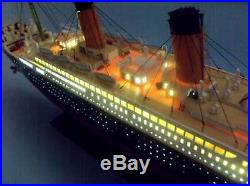
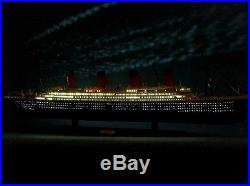
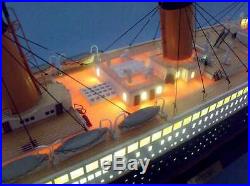
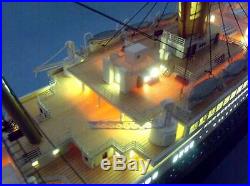
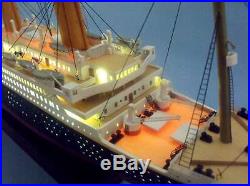
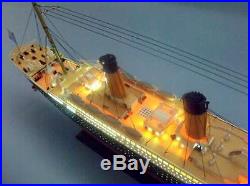
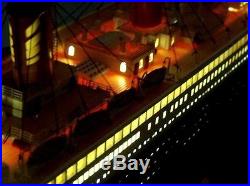
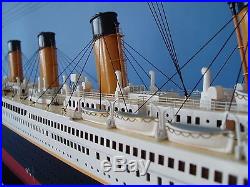
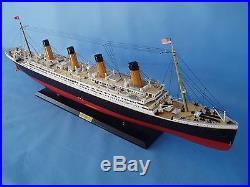
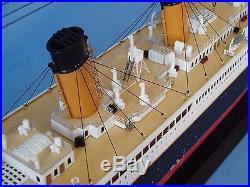
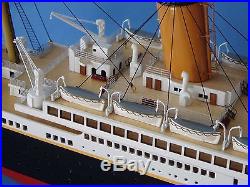

Welcome To BC Fishing World. Sparkling like a jeweled star in the heavens, this Limited Edition scale replica RMS Titanic model shines with a graceful luster and evokes the elegance and grandeur of historys most famous ocean liner. Exquisite craftsmanship combines with attention to every detail to produce a graceful and opulent museum-quality replica worthy of the RMS Titanic herself. 40″ Long x 5″ Wide x 13.5 High (1:265 scale). LED lighting upgrade over our 40 RMS Titanic Limited. Bright LED lights line the entire inside of the hull and shine brightly. Lifelike lighting when compared to the actual RMS Titanic due to accurate window and porthole placements. Plugs into any electrical outlet – Detachable electrical cord comes out of the back of the base. Longevity and brightness (LED light typical usage time 10+ years). Paint colors precisely matched to those of the actual RMS Titanic. All windows and portholes exactly sized and positioned according to the original construction plans. Historically accurate design and detailing of superstructure and hull. Open promenade decks visible through superstructure windows. Precise superstructure design and detailing. Triple propeller design and accurate anchors. Metal trussed crane booms with twin cables and pulleys on cargo hooks. Lattice grating on ducts and vents. Finely-crafted wire maintenance ladders ascend smokestacks. Lifeboats hung from launching davits. Rigging and stay-lines on all masts and smokestacks. Delicate four-wire metal railings on forecastle, aftcastle and atop superstructure. All ladders, staircases and handrails produced from delicate metal wire. Clear panes in all deckhouse windows. Numerous deck objects and features include deck cleats, vent shafts, lattice grates, miniature benches and more. Built from scratch by our master artisans. High quality woods include cherry, birch, maple and rosewood. Of this RMS Titanic model. Extensive research of original plans, historical drawings and paintings as well as actual photographs ensures the highest possible accuracy. Check out my other items. At the dawn of the 20th century, a time of great prosperity and industrial advancement known as the Gilded Age, sea travel began a transformation that would take it from an undesirable yet necessary mode of transportation to that of a luxurious and much sought after experience. At the forefront of such nautical achievement the Cunard Lines and White Star Lines sought to create the largest and most grandiose vessels the world had ever seen. Both a legend and a tragedy, a shining example of man’s ingenuity as well as a warning against unchecked pride, the RMS Titanic will live on forever in the annals of history. With the aid of shipbuilder William Pirrie and general manager Alexander Carlisle, the plans for the Titanic were complete and her hull readied to be laid down for construction just two years later. Launched on May 31, 1911, and completed on March 31, 1912, the RMS Titanic emerged as the world’s largest passenger steamship, a true nautical gem for all who beheld her. At 882 feet long, with a beam of 92 feet and a height of 175 feet, the Titanic loomed over neighboring ships, her double plated steel hull gleaming with promise and excitement. Docked at Belfast, Ireland’s Harland and Wolff Shipyads, the 50,000 ton Titanic was a marvel of engineering for the time. 29 boilers, with a total of 159 coal furnaces, powered the massive 15,000 Hp reciprocating engines, while two triple-blade propellers and one quadruple-blade center propeller were crafted from gleaming bronze. Fitted with three towering 62-foot funnels, these massive engines made the Titanic the largest moveable man-made object in the world. As with any design and construction project, once the groundwork had been laid it was time to appoint the Titanic with the luxurious amenities and accoutrements that would elevate her to her legendary status. First class was dominated by a shimmering 6-story, glass-domed central staircase, lit by chandelier and radiating the elegant atmosphere of the vessel (made famous as a primary set in the Hollywood blockbuster Titanic). Leading from this staircase, first class passengers could enter the fabulous dining saloon or continue on to the Palm Court or the Verandah Restaurant. Parisien was also a favorite with guests, where for the first time passengers could enjoy sea views through the restaurant’s large picture windows, or even dine al fresco; standard on today’s grand ships, this feature was an exciting innovation at the time. First class passengers were also privy to the Titanic’s fully operational telephone system, a stylish barber shop, and a library, while further innovations would become industry standards in the century after her creation. Adding to the already opulent accommodations, the first class section also offered guests a pool, squash court, Turkish bath, electric baths, two music ensembles (instead of the usual one), and a gym complete with mechanical horse and camel for the era’s premier riders. Along with such fine trappings throughout her decks the Titanic also boasted elegant staterooms, spacious and comfortable, crafted from rich woods and ornate paneling and bedecked with the finest furniture. While the first class was incomparably elegant, third class passengers were still greeted with their own remarkable staterooms. While these were not fancy or opulent in any way, they did boast indoor toilets, which at the time were not even a standard feature in the average home. With her construction complete, the Titanic was paced through her sea trials on April 2, 1912, just under a week before her doomed departure. Following her successful sea trials, the Titanic departed from the Harland and Wolff Shipyards en route to Southampton, England for her maiden voyage. Captained by 62-year-old Edward J. Setting sail to great fanfare and celebration, the fabulous RMS Titanic was truly the grandest vessel ever created, carrying nearly 2,000 people as it made its fateful voyage. As befit such a magnificent vessel many of the world’s most prominent and wealthy citizens boarded her in what they believed would be the greatest cruise the world had ever witnessed. Included on the docket were the likes of billionaire John Jacob Astor IV and his wife Madeleine Force Astor, industrialist Benjamin Guggenheim, Macy’s owner Isidor Straus, and the soon to be legendary Margaret “Molly” Brown. Morgan was scheduled to depart on the Titanic, his trip was fortuitously cancelled at the last minute. Sailing from Southampton the Titanic made port in Cherbourg, France, to accommodate additional passengers then made one final stop in Queenstown, Ireland before venturing out into the Atlantic. For four magnificent days the RMS Titanic cruised across the Atlantic, her 2,223 passengers enjoying unheard of luxuries and accommodations. From dips in the pool, to wonderful music, dances, and the finest cuisine served in 10-course meals, life aboard the Titanic was truly magical before her untimely demise. Less than a day before the accident Captain Smith had put the Titanic on a more southerly course, attempting to steer clear of the dangerous waters North after being advised by other ships via radio. That Sunday evening, while passengers were enjoying the joyous ambiance, flowing live music, and enviable cuisine, the Titanic continued her deadly course through the dark waters. With no moon on April 14, in completely placid, glassy waters, icebergs became difficult to detect, with no waves to crash against their sides and no moonlight to illuminate them. Hired by Marconi, not employed by White Star Lines, the two operators were tasked with personal communications messages instead of messages to the bridge; an oversight that very well could have altered the course of history for the Titanic. Continuing throughout the remainder of the day, five additional iceberg warnings were received, though none reached the bridge. Within less than 10 hours, Titanic would be sinking. Sounding the warning bell three times, lookout Frederick Fleet telephoned the bridge, prompting the 1st Officer to give the order for emergency evasive action. With a relatively small rudder, compared with the massive Cunard Ships, the Titanic operated extremely efficiently while cruising but suffered from impaired mobility when attempting to change course. Just 20 minutes after the impact the forward 3rd-Class spaces began to flood, and within half an hour the first of the lifeboats were being loaded and lowered into the water. During this time radio operators Phillips and Bride were sending CQD distress signals as well as the newly created SOS signals, which were received by numerous ships nearby. Though within distance, many of the ships were far too slow to arrive in time for any assistance, the Carpathia the only one that came to the Titanic’s aid. A mere 58 miles away, the Carpathia steamed towards the ailing Titanic, though her arrival four hours later would be too late to save the majority of passengers and crew. It was also at this time that the Titanic’s most glaring and egregious error came to light: her woefully inadequate lifeboats. With 2,223 passengers and crew aboard, the Titanic only carried 20 lifeboats with a maximum capacity of 1,178; far lower than necessary, yet above the legal standards for ships of the time. In the ensuing panic following the collision, many of these lifeboats were launched prematurely, with only a few people aboard or without proper protocol, causing some to capsize and others to simply float away from the dying vessel. Compounding the already horrific accident, this lack of safety equipment contributed to the deaths of more than 1,500. Within a few hours of the Titanic’s sinking the Carpathia arrived to rescue the stranded survivors from the 28 degree water. Three days after that awful ordeal, on April 18, 1912, the Carpathia steamed into New York’s Pier 54 much to the relief of the survivors and their families. While the Titanic may have been silenced forever, her legacy endured and positive change was enacted. On September 1st, 1985, the long sought after wreck of the Titanic was discovered by a joint American and French expedition. A glowing testament to mankind’s ingenuity and ability, a stark reminder of overconfidence and shortsighted pride, a fabulous history and exciting mystery, and a tragedy to be remembered forever. The item “RMS Titanic Limited Model Cruise Ship 40 with LED Lights” is in sale since Tuesday, February 23, 2016. This item is in the category “Toys & Hobbies\Models & Kits\Boats, Ships\Wooden”. The seller is “bcfishingworld” and is located in Fort Myers, Florida. This item can be shipped to United States, to Canada, to United Kingdom, DK, RO, SK, BG, CZ, FI, HU, LV, LT, MT, EE, to Australia, GR, PT, CY, SI, to Japan, to China, SE, KR, ID, to Taiwan, ZA, TH, to Belgium, to France, to Hong Kong, to Ireland, to Netherlands, PL, to Spain, to Italy, to Germany, to Austria, RU, IL, to Mexico, to New Zealand, SG, to Switzerland, NO, SA, UA, AE, QA, KW, BH, HR, MY, TR, BR, CL, CO, CR, PA, TT, GT, HN, JM.
- Brand: Handcrafted Model Ships
- MPN: SKU#: A1701 Lights
- Year: 2015
- Country/Region of Manufacture: United States
